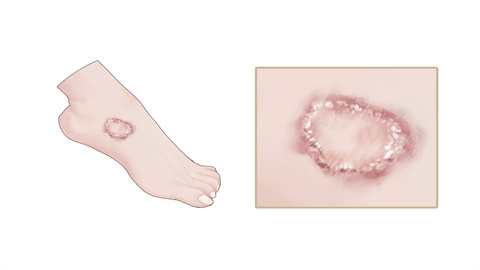Itchy soles of the feet that become more itchy when scratched — what are the possible causes?
Generally, itchy soles that become more itchy when scratched may be caused by dry skin, uncomfortable shoes and socks, athlete's foot, eczema, dyshidrotic eczema, and other reasons. It is recommended to seek medical advice promptly and undergo treatment under a doctor's guidance. Detailed analysis is as follows:

1. Dry Skin
When the skin on the soles lacks moisture, the barrier function of the stratum corneum is compromised, making nerve endings more susceptible to irritation, thus producing a sensation of itching. Scratching further damages the skin barrier, leading to increased itchiness. After washing feet, apply moisturizing cream timely to maintain skin hydration, and avoid frequently soaking feet in excessively hot water.
2. Inappropriate Shoes and Socks
Wearing non-breathable shoes and socks can cause the feet to remain in a hot and humid environment, affecting normal skin metabolism, making it easier for bacteria to proliferate and irritate the skin, causing itching. Additionally, improper sizing can cause friction on the soles, exacerbating the itching. Choose breathable and well-fitting shoes and socks, preferably cotton material, and change shoes and socks frequently.
3. Athlete's Foot
Athlete's foot is mainly caused by infection with dermatophytes. Fungi grow and multiply in warm, moist environments, damaging the stratum corneum of the foot skin, stimulating nerve endings, and causing itching. After scratching, skin damage allows fungi to spread more easily, intensifying the itch. Symptoms such as blisters and erosion may also appear. Treatment may include topical antifungal medications like miconazole nitrate cream, terbinafine hydrochloride cream, or bifonazole cream, under a doctor's instructions.
4. Eczema
Eczema is triggered by various internal and external factors, such as contact allergens, endocrine and metabolic changes. Eczema causes skin inflammatory reactions, reducing the skin's barrier function and increasing the sensitivity of sensory nerve endings, resulting in itching. Scratching worsens the inflammation and intensifies the itch. Symptoms such as redness, papules, and exudation may also occur. Treatment may involve medications like calamine lotion, desonide cream, or mometasone furoate cream, as advised by a physician.
5. Dyshidrotic Eczema
Dyshidrotic eczema may be associated with mental factors, allergic constitution, and localized infections. Blocked sweat ducts and retained sweat form small blisters, which irritate surrounding tissues and cause itching. Scratching causes the blisters to rupture, leading to infection and intensified itching. Symptoms such as pain and peeling may also occur. Treatment should follow medical advice and may include triamcinolone urea ointment, tacrolimus ointment, or loratadine tablets.
In daily life, avoid sharing slippers, foot basins, and other personal items with others. Maintain good foot ventilation and avoid keeping feet covered for extended periods. Also, maintain a balanced diet and control blood sugar levels to prevent diabetes-related complications.




